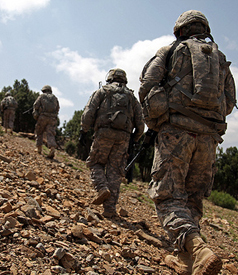
US Commander in Afghanistan Submits Request for More Troops
Nancy A. Youssef - McClatchy Newspapers
Washington - Army Gen. Stanley McChrystal, the U.S. military commander in Afghanistan, hand-delivered his request for as many as 45,000 more troops to the chairman of the Joint Chiefs of Staff in Germany Friday and made his case for why he needs more forces to fight an increasingly unpopular war.

Near the village of Kowtay, Afghanistan, US soldiers patrol an area. General McChrystal has submitted a request for up to 45,000 more troops to be deployed to Afghanistan. (Photo: Staff Sgt.
Adm. Michael Mullen, the chairman of the Joint Chiefs of Staff, traveled to Ramstein Air Base in Germany to meet with McChrystal and get "a better understanding of the pending resource requirement," a Pentagon official told McClatchy. The official wasn't authorized to speak publicly and requested anonymity.
Pentagon spokesman Geoff Morrell said that Secretary of Defense Robert Gates wouldn't share McChrystal's troop request with anyone until the administration completes its review of the situation in Afghanistan. Only then will other top Pentagon officials review the request and make comments before submitting it to the White House for President Barack Obama to consider, he said.
"It will not be worked in this building by anyone until the assessment process is complete," Morrell said.
McChrystal submitted his assessment of the situation in Afghanistan in August, calling the situation dire but saying the U.S. and its allies still have a chance to succeed if more troops are committed. The White House, however, asked him to not submit a request for more troops until it had time to review his assessment.
Obama and his top national security advisers are locked in a heated debate about the way forward in Afghanistan. The administration announced in March that it had a strategy for Afghanistan, but it's had a difficult time defining the strategy amid declining political and public support, mounting U.S. casualties, evidence that Afghan President Hamid Karzai rigged his re-election last month, pervasive official corruption, a resurgent Taliban and halfhearted assistance from neighboring Pakistan.
A CBS News/New York Times poll released Friday found that 29 percent of Americans think the U.S. should send more troops to Afghanistan, compared with 42 percent in February.
Five more American service members were killed Thursday in southern Afghanistan, three of them from an improvised explosive device, according to NATO's International Security Assistance Force. By mid-August, 2009 became the deadliest year for U.S. troops in Afghanistan since the war began eight years ago. At least 33 troops have been killed this month.
Top administration officials have vacillated between committing more resources and redefining their objectives. Earlier this month, Mullen said that the U.S. "probably" would send more troops to Afghanistan, but a day later Vice President Joe Biden called any discussion of future troop deployments premature.
Defense officials told McClatchy that they think Obama is now "leaning" toward Biden's position that the U.S. should begin to shift away from the counterinsurgency strategy championed by McChrystal and his immediate boss, Army Gen. David Petraeus, the head of the U.S. Central Command, which the administration embraced earlier this year.
Instead of sending more troops to secure Afghanistan and bolster the country's unpopular central government, the advocates of a change in strategy argue, the U.S. should make deals with local warlords to use their turf to monitor Taliban and al Qaida activity and launch more unmanned drone attacks on terrorist targets in Afghanistan and the border areas of Pakistan.
If Karzai is re-elected, as appears likely, but his election is considered illegitimate, they argue, that could further undercut domestic support for the Afghanistan war and leave the White House hitched to an unpopular leader in Kabul. In addition, it would mean that the U.S. exit strategy would become training 134,000 Afghan soldiers to serve a government that the U.S. considers corrupt and incompetent.
Earlier this year, Obama approved sending 17,700 more combat troops and 4,000 trainers for Afghanistan. They all should arrive by November, bringing the U.S. troop total in Afghanistan to 68,000. There currently are 65,000 U.S. troops and 39,000 NATO troops.
--------
Hal Bernton of The Seattle Times contributed to this article from Kandahar, Afghanistan.
